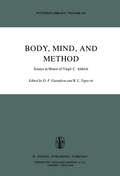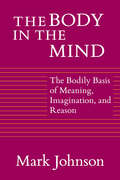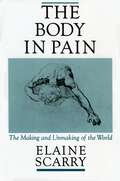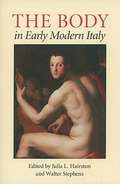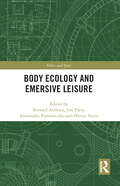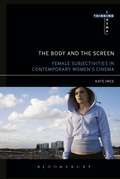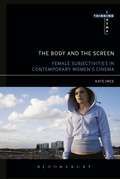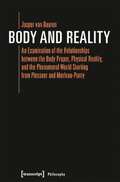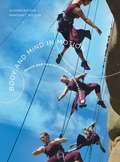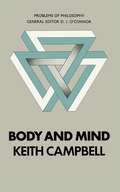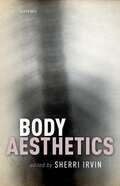- Table View
- List View
Body, Mind, and Method: Essays in Honor of Virgil C. Aldrich (Synthese Library #138)
by Donald F. Gustafson and Bangs L. TapscottSimple seeing. Plain talking. Language in use and persons in action. These are among the themes of Virgil Aldrich's writings, from the 1930's onward. Throughout these years, he has been an explorer of conceptual geography: not as a foreign visitor studying an alien land, but close up 'in the language in which we live, move, and have our being'. This is his work. It is clear to those who know him best that he also has fun at it. Yet, in the terms of his oft-cited distinction, it is equally clear that he is to be counted not among the funsters of philosophy, but among its most committed workers. Funsters are those who attempt to do epistemology, metaphysics, or analysis by appealing to examples which are purely imaginary, totally fictional, as unrealistic as you like, 'completely unheard of'. Such imaginative wilfullness takes philosophers away from, not nearer to, 'the rough ground' (Wittgenstein) where our concepts have their origin and working place. In the funsters' imagined, 'barely possible' (but actually impossible) world, simple seeing becomes transformed into the sensing of sense-data; plain talk is rejected as imprecise, vague, and misleading; and per sons in action show up as ensouled physical objects in motion. Then the fly is in the bottle, buzzing out its tedious tunes: the problem of perception of the external world; the problem of meaning and what it is; the mind-body problem. Image-mongering has got the best of image-management.
The Body in the Mind: The Bodily Basis of Meaning, Imagination, and Reason
by Mark Johnson"There are books—few and far between—which carefully, delightfully, and genuinely turn your head inside out. This is one of them. It ranges over some central issues in Western philosophy and begins the long overdue job of giving us a radically new account of meaning, rationality, and objectivity."—Yaakov Garb, San Francisco Chronicle
The Body in Spinoza and Nietzsche
by Razvan IoanThis engaging volume sheds light on the central role the turn to the body plays in the philosophies of Spinoza and Nietzsche, providing an ideal starting point for understanding their work. Ioan explores their critiques of traditional morality, as well as their accounts of ethics, freedom and politics, arguing that we can best compare their respective philosophical physiologies, and their broader philosophical positions, through their shared interest in the notion of power. In spite of significant differences, Ioan shows the ways in which the two thinkers share remarkable similarities, delving into their emphatic appeal to the body as the key to solving fundamental philosophical problems, both theoretical and practical.
The Body in Pain: The Making and Unmaking of the World
by Elaine ScarryPart philosophical meditation, part cultural critique, The Body in Pain is a profoundly original study that has already stirred excitement in a wide range of intellectual circles. The book is an analysis of physical suffering and its relation to the numerous vocabularies and cultural forces--literary, political, philosophical, medical, religious--that confront it. Elaine Scarry bases her study on a wide range of sources: literature and art, medical case histories, documents on torture compiled by Amnesty International, legal transcripts of personal injury trials, and military and strategic writings by such figures as Clausewitz, Churchill, Liddell Hart, and Kissinger, She weaves these into her discussion with an eloquence, humanity, and insight that recall the writings of Hannah Arendt and Jean-Paul Sartre. Scarry begins with the fact of pain's inexpressibility. Not only is physical pain enormously difficult to describe in words--confronted with it, Virginia Woolf once noted, "language runs dry"--it also actively destroys language, reducing sufferers in the most extreme instances to an inarticulate state of cries and moans. Scarry analyzes the political ramifications of deliberately inflicted pain, specifically in the cases of torture and warfare, and shows how to be fictive. From these actions of "unmaking" Scarry turns finally to the actions of "making"--the examples of artistic and cultural creation that work against pain and the debased uses that are made of it. Challenging and inventive, The Body in Pain is landmark work that promises to spark widespread debate.
The Body in Medical Thought and Practice (Philosophy and Medicine #43)
by DrewLederIn the second half of the 20th century, the body has become a central theme of intellectual debate. How should we perceive the human body? Is it best understood biologically, experientially, culturally? How do social institutions exercise power over the body and determine norms of health and behavior? The answers arrived at by phenomenologists, social theorists, and feminists have radically challenged our cenventional notions of the body dating back to 17th century Cartesian thought. This is the first volume to systematically explore the range of contemporary thought concerning the body and draw out its crucial implications for medicine. Its authors suggest that many of the problems often found in modern medicine -- dehumanized treatment, overspecialization, neglect of the mind's healing resources -- are directly traceable to medicine's outmoded concepts of the body. New and exciting alternatives are proposed by some of the foremost physicians and philosophers working in the medical humanities today.
The Body In Early Modern Italy (PDF)
by Julia L. Hairston Walter StephensHuman bodies have been represented and defined in various ways across different cultures and historical periods. As an object of interpretation and site of social interaction, the body has throughout history attracted more attention than perhaps any other element of human experience. The essays in this volume explore the manifestations of the body in Italian society from the fourteenth through the seventeenth centuries. Adopting a variety of interdisciplinary approaches, these fresh and thought-provoking essays offer original perspectives on corporeality as understood in the early modern literature, art, architecture, science, and politics of Italy. An impressively diverse group of contributors comment on a broad range and variety of conceptualizations of the body, creating a rich dialogue among scholars of early modern Italy. Contributors: Albert R. Ascoli, University of California, Berkeley; Douglas Biow, The University of Texas at Austin; Margaret Brose, University of California, Santa Cruz; Anthony Colantuono, University of Maryland, College Park; Elizabeth Horodowich, New Mexico State University; Sergius Kodera, New Design University, St. Pölten, Austria; Jeanette Kohl, University of California, Riverside; D. Medina Lasansky, Cornell University; Luca Marcozzi, Roma Tre University; Ronald L. Martinez, Brown University; Katharine Park, Harvard University; Sandra Schmidt, Free University of Berlin; Bette Talvacchia, University of Connecticut
Body Images: Embodiment as Intercorporeality
by Gail WeissDrawing on relevant discussions of embodiment in phenomenology, feminist theory, psychoanalytic theory, queer theory and post-colonial theory, Body Images explores the role played by the body image in our everyday existence.
Body Images: Embodiment as Intercorporeality
by Gail WeissDrawing on relevant discussions of embodiment in phenomenology, feminist theory, psychoanalytic theory, queer theory and post-colonial theory, Body Images explores the role played by the body image in our everyday existence.
Body Ecology and Emersive Leisure (Ethics and Sport)
by Bernard Andrieu Jim Parry Alessandro Porrovecchio Olivier SirostThe emerging field of body ecology offers fresh insights into how the body engages with its surrounding environment through consciousness, perception, knowledge and emotion. In this groundbreaking collection, leading scholars of sport, leisure and philosophy draw on research on topics as diverse as surfing, freediving, slacklining, parkour, bodybuilding, dance and circus arts to flesh out the concept of body ecology and its potential for helping us understand our connection with the world around us. Touching on theories of subjectivity, embodiment, pleasure and play, this book explores different approaches to studying body ecology as a way of conceptualising the experience of being immersed in nature, in the elements and in one’s own body through the power of awareness. An experience becomes emersive when it involves the production of new emotions in the body: emersion is the activation of what is living within the body itself. Shedding new light on the possibilities of physical cultural studies, Body Ecology and Emersive Leisure is fascinating reading for all students and scholars with an interest in sport, leisure, philosophy and the body.
Body Ecology and Emersive Leisure (Ethics and Sport)
by Bernard Andrieu Jim Parry Alessandro Porrovecchio Olivier SirostThe emerging field of body ecology offers fresh insights into how the body engages with its surrounding environment through consciousness, perception, knowledge and emotion. In this groundbreaking collection, leading scholars of sport, leisure and philosophy draw on research on topics as diverse as surfing, freediving, slacklining, parkour, bodybuilding, dance and circus arts to flesh out the concept of body ecology and its potential for helping us understand our connection with the world around us. Touching on theories of subjectivity, embodiment, pleasure and play, this book explores different approaches to studying body ecology as a way of conceptualising the experience of being immersed in nature, in the elements and in one’s own body through the power of awareness. An experience becomes emersive when it involves the production of new emotions in the body: emersion is the activation of what is living within the body itself. Shedding new light on the possibilities of physical cultural studies, Body Ecology and Emersive Leisure is fascinating reading for all students and scholars with an interest in sport, leisure, philosophy and the body.
The Body as Object and Instrument of Knowledge: Embodied Empiricism in Early Modern Science (Studies in History and Philosophy of Science #25)
by Charles T. Wolfe Ofer GalIt was in 1660s England, according to the received view, in the Royal Society of London, that science acquired the form of empirical enquiry we recognize as our own: an open, collaborative experimental practice, mediated by specially-designed instruments, supported by civil discourse, stressing accuracy and replicability. Guided by the philosophy of Francis Bacon, by Protestant ideas of this worldly benevolence, by gentlemanly codes of decorum and by a dominant interest in mechanics and the mechanical structure of the universe, the members of the Royal Society created a novel experimental practice that superseded former modes of empirical inquiry, from Aristotelian observations to alchemical experimentation.This volume focuses on the development of empiricism as an interest in the body – as both the object of research and the subject of experience. Re-embodying empiricism shifts the focus of interest to the ‘life sciences’; medicine, physiology, natural history. In fact, many of the active members of the Royal Society were physicians, and a significant number of those, disciples of William Harvey and through him, inheritors of the empirical anatomy practices developed in Padua during the 16th century. Indeed, the primary research interests of the early Royal Society were concentrated on the body, human and animal, and its functions much more than on mechanics. Similarly, the Académie des Sciences directly contradicted its self-imposed mandate to investigate Nature in mechanistic fashion, devoting a significant portion of its Mémoires to questions concerning life, reproduction and monsters, consulting empirical botanists, apothecaries and chemists, and keeping closer to experience than to the Cartesian standards of well-founded knowledge.These highlighted empirical studies of the body, were central in a workshop in the beginning of 2009 organized by the unit for History and Philosophy of Science in Sydney. The papers that were presented by some of the leading figures in this area are presented in this volume.
The Body and the Screen: Female Subjectivities in Contemporary Women’s Cinema (Thinking Cinema)
by Kate InceWinner of the British Association of Film, Television and Screen Studies Best Book Prize 2018Since the 1980s the number of women regularly directing films has increased significantly in most Western countries; in France, Claire Denis and Catherine Breillat have joined Agnès Varda in gaining international renown, while British directors Lynne Ramsay and Andrea Arnold have forged award-winning careers in feature film. This new volume in the "Thinking Cinema†? series draws on feminist philosophers and theorists from Simone de Beauvoir on to offer readings of a range of the most important and memorable of these films from the 1990s and 2000s, focusing as it does so on how the films convey women's lives and identities. Mainstream entertainment cinema traditionally distorts the representation of women, objectifying their bodies, minimizing their agency, and avoiding the most important questions about how cinema can "do justice" to female subjectivity. Kate Ince suggests that the films of independent women directors are progressively redressing the balance, reinvigorating both the narratives and the formal ambitions of European cinema. Ince uses feminist philosophers to interpret such films as Sex Is Comedy, Morvern Callar, White Material, and Fish Tank anew, suggesting that a philosophical understanding of female subjectivity as embodied and ethical should underpin future feminist film study.
The Body and the Screen: Female Subjectivities in Contemporary Women’s Cinema (Thinking Cinema)
by Kate InceWinner of the British Association of Film, Television and Screen Studies Best Book Prize 2018Since the 1980s the number of women regularly directing films has increased significantly in most Western countries; in France, Claire Denis and Catherine Breillat have joined Agnès Varda in gaining international renown, while British directors Lynne Ramsay and Andrea Arnold have forged award-winning careers in feature film. This new volume in the “Thinking Cinema” series draws on feminist philosophers and theorists from Simone de Beauvoir on to offer readings of a range of the most important and memorable of these films from the 1990s and 2000s, focusing as it does so on how the films convey women's lives and identities. Mainstream entertainment cinema traditionally distorts the representation of women, objectifying their bodies, minimizing their agency, and avoiding the most important questions about how cinema can "do justice" to female subjectivity. Kate Ince suggests that the films of independent women directors are progressively redressing the balance, reinvigorating both the narratives and the formal ambitions of European cinema. Ince uses feminist philosophers to interpret such films as Sex Is Comedy, Morvern Callar, White Material, and Fish Tank anew, suggesting that a philosophical understanding of female subjectivity as embodied and ethical should underpin future feminist film study.
Body and Soul: Essays on Aristotle's Hylomorphism
by Jennifer WhitingBody and Soul: Essays on Aristotle's Hylomorphism is one of three volumes collecting previously published essays by Jennifer Whiting. This volume contains two sets of essays, one centered on Aristotle's account of an animal's body as standing to its soul as matter (hulê) to form (morphê), the other exploring Aristotle's conception of practical reason as the proper form of human desire. In the first set Whiting presents Aristotle's conception of the soul as the form and essence of an organic (and so living) body as part of his solution to Presocratic puzzles about whether there is a real (and not simply conventional) distinction between the coming-to-be (or passing-away) of an individual substance and what is merely the alteration or rearrangement of pre-existing stuffs. The solution also involves taking each individual animal within a species to have its own numerically distinct "individual" form, which (unlike species forms traditionally conceived) exists when and only when it does. The remaining essays account for various deficiencies in the lives of rational animals by appeal to the explanatory asymmetries afforded by Aristotle's teleology, where formal and final causes dominate when things go as they should (teleologically speaking) go, and material-efficient causes dominate when things go wrong. Just as Aristotle traces the birth of females to the failure of menstrual fluid to be fully "mastered" by the formal movements in the father's semen, so too he traces akratic and other defective forms of action to the failure of desires to be fully "mastered" by the activities of reason. Whiting argues that phronêsis is on this account the proper form of the desiring part of the soul, which (when things go well) is one with the practically reasoning part.
Body and Soul: Essays on Aristotle's Hylomorphism
by Jennifer WhitingBody and Soul: Essays on Aristotle's Hylomorphism is one of three volumes collecting previously published essays by Jennifer Whiting. This volume contains two sets of essays, one centered on Aristotle's account of an animal's body as standing to its soul as matter (hulê) to form (morphê), the other exploring Aristotle's conception of practical reason as the proper form of human desire. In the first set Whiting presents Aristotle's conception of the soul as the form and essence of an organic (and so living) body as part of his solution to Presocratic puzzles about whether there is a real (and not simply conventional) distinction between the coming-to-be (or passing-away) of an individual substance and what is merely the alteration or rearrangement of pre-existing stuffs. The solution also involves taking each individual animal within a species to have its own numerically distinct "individual" form, which (unlike species forms traditionally conceived) exists when and only when it does. The remaining essays account for various deficiencies in the lives of rational animals by appeal to the explanatory asymmetries afforded by Aristotle's teleology, where formal and final causes dominate when things go as they should (teleologically speaking) go, and material-efficient causes dominate when things go wrong. Just as Aristotle traces the birth of females to the failure of menstrual fluid to be fully "mastered" by the formal movements in the father's semen, so too he traces akratic and other defective forms of action to the failure of desires to be fully "mastered" by the activities of reason. Whiting argues that phronêsis is on this account the proper form of the desiring part of the soul, which (when things go well) is one with the practically reasoning part.
Body and Reality: An Examination of the Relationships between the Body Proper, Physical Reality, and the Phenomenal World Starting from Plessner and Merleau-Ponty (Edition Moderne Postmoderne)
by Jasper van BuurenIs materialism right to claim that the world of everyday-life experience - the phenomenal world - is nothing but an illusion produced in physical reality, notably in the brain? Or is Merleau-Ponty right when he defends the fundamental character of the phenomenal world while rejecting physical realism? Jasper van Buuren addresses these questions by exploring the nature of the body proper in Merleau-Ponty and Plessner, arguing that physical and phenomenal realism are not mutually exclusive but complementary. The argument includes a close examination of the relationships between scientific and pre-scientific perspectives, between living and non-living things, and between humans and animals.
Body and Practice in Kant (Studies in German Idealism #6)
by Helge SvareKant is generally conceived to have offered little attention to the fact that we experience the world in and through our bodies. This book argues that this standard image of the great German philosopher is radically wrong. Not only does Kant - throughout his career and in works published before and after the Critique of pure reason - reflect constantly upon the fact that human life is embodied, but the Critique of pure reason itself may be read as a critical reflection aimed at exploring some significant philosophical implications of this fact. Bringing this aspect of Kant's philosophy into focus is important, not only because it sheds new light on our understanding of Kant's work, but also because it is relevant to contemporary discussions in philosophy about embodiment, learning and practice. By taking his philosophy of embodiment into account, the author makes Kant stand out as a true contemporary in new and unexpected ways.
Body and Mind in Motion: Dance and Neuroscience in Conversation (PDF)
by Glenna Batson Margaret WilsonDrawing from the burgeoning field of 'embodiment' – itself an idea at the intersection of the sciences, humanities, arts and technologies – Body and Mind in Motion highlights the relevance of somatic education within dance education, dance science and body-mind studies.
Body-and Image-Space: Re-Reading Walter Benjamin (Warwick Studies in European Philosophy)
by Sigrid WeigelThe last decade has seen a new wave of interest in philosophical and theoretical circles in the writings of Walter Benjamin. In Body-and Image-Space Sigrid Weigel, one of Germany's leading feminist theorists and a renowned commentator on the work of Walter Benjamin, argues that the reception of his work has so far overlooked a crucial aspect of his thought - his use of images. Weigel shows that it is precisely his practice of thinking in images that holds the key to understanding the full complexity, richness and topicality of Benjamin's theory.
Body-and Image-Space: Re-Reading Walter Benjamin (Warwick Studies in European Philosophy)
by Sigrid WeigelThe last decade has seen a new wave of interest in philosophical and theoretical circles in the writings of Walter Benjamin. In Body-and Image-Space Sigrid Weigel, one of Germany's leading feminist theorists and a renowned commentator on the work of Walter Benjamin, argues that the reception of his work has so far overlooked a crucial aspect of his thought - his use of images. Weigel shows that it is precisely his practice of thinking in images that holds the key to understanding the full complexity, richness and topicality of Benjamin's theory.
Body and Gender, Soul and Reason in Late Antiquity
by Gillian ClarkWhat does it mean to say that a human being is body and soul, and how does each affect the other? Late antique philosophers, Christians included, asked these central questions. The papers collected here explore their answers, and use those answers to ask further questions, reading Iamblichus, Porphyry, Augustine and others in their social and intellectual context. Among the topics dealt with are the following. Humans are mortal rational beings, so how does the mortal body affect the rational soul? The body needs food: what foods are best for the soul, and is it right to eat animal foods if animals are less rational than humans? The body is gendered for reproduction: are reason and the soul also gendered? Ascetic lifestyles may free our bodies from the limitations of gender and desire, so that our souls are free to reconnect with the divine; but this need must be balanced with the claims of family and society. Philosophers asked whether life in the body is exile for the soul; Christians defended their claim that body as well as soul would live after death, and even the smallest fragment of a martyr's body is proof of resurrection.
Body and Gender, Soul and Reason in Late Antiquity
by Gillian ClarkWhat does it mean to say that a human being is body and soul, and how does each affect the other? Late antique philosophers, Christians included, asked these central questions. The papers collected here explore their answers, and use those answers to ask further questions, reading Iamblichus, Porphyry, Augustine and others in their social and intellectual context. Among the topics dealt with are the following. Humans are mortal rational beings, so how does the mortal body affect the rational soul? The body needs food: what foods are best for the soul, and is it right to eat animal foods if animals are less rational than humans? The body is gendered for reproduction: are reason and the soul also gendered? Ascetic lifestyles may free our bodies from the limitations of gender and desire, so that our souls are free to reconnect with the divine; but this need must be balanced with the claims of family and society. Philosophers asked whether life in the body is exile for the soul; Christians defended their claim that body as well as soul would live after death, and even the smallest fragment of a martyr's body is proof of resurrection.
Body Aesthetics (PDF)
by Sherri IrvinThe body is a rich object for aesthetic inquiry. We aesthetically assess both our own bodies and those of others, and our felt bodily experiences-as we eat, have sex, and engage in other everyday activities-have aesthetic qualities. The body, whether depicted or actively performing, features centrally in aesthetic experiences of visual art, theatre, dance and sports. Body aesthetics can be a source of delight for both the subject and the object of the gaze. But aesthetic consideration of bodies also raises acute ethical questions: the body is deeply intertwined with one's identity and sense of self, and aesthetic assessment of bodies can perpetuate oppression based on race, gender identity, sexual orientation, age, size, and disability. Artistic and media representations shape how we see and engage with bodies, with consequences both personal and political. This volume contains sixteen original essays by contributors in philosophy, sociology, dance, disability theory, critical race studies, feminist theory, medicine, and law. Contributors take on bodily beauty, sexual attractiveness, the role of images in power relations, the distinct aesthetics of disabled bodies, the construction of national identity, the creation of compassion through bodily presence, the role of bodily style in moral comportment, and the somatic aesthetics of racialized police violence.
Body Aesthetics
by Sherri IrvinThe body is a rich object for aesthetic inquiry. We aesthetically assess both our own bodies and those of others, and our felt bodily experiences-as we eat, have sex, and engage in other everyday activities-have aesthetic qualities. The body, whether depicted or actively performing, features centrally in aesthetic experiences of visual art, theatre, dance and sports. Body aesthetics can be a source of delight for both the subject and the object of the gaze. But aesthetic consideration of bodies also raises acute ethical questions: the body is deeply intertwined with one's identity and sense of self, and aesthetic assessment of bodies can perpetuate oppression based on race, gender identity, sexual orientation, age, size, and disability. Artistic and media representations shape how we see and engage with bodies, with consequences both personal and political. This volume contains sixteen original essays by contributors in philosophy, sociology, dance, disability theory, critical race studies, feminist theory, medicine, and law. Contributors take on bodily beauty, sexual attractiveness, the role of images in power relations, the distinct aesthetics of disabled bodies, the construction of national identity, the creation of compassion through bodily presence, the role of bodily style in moral comportment, and the somatic aesthetics of racialized police violence.
